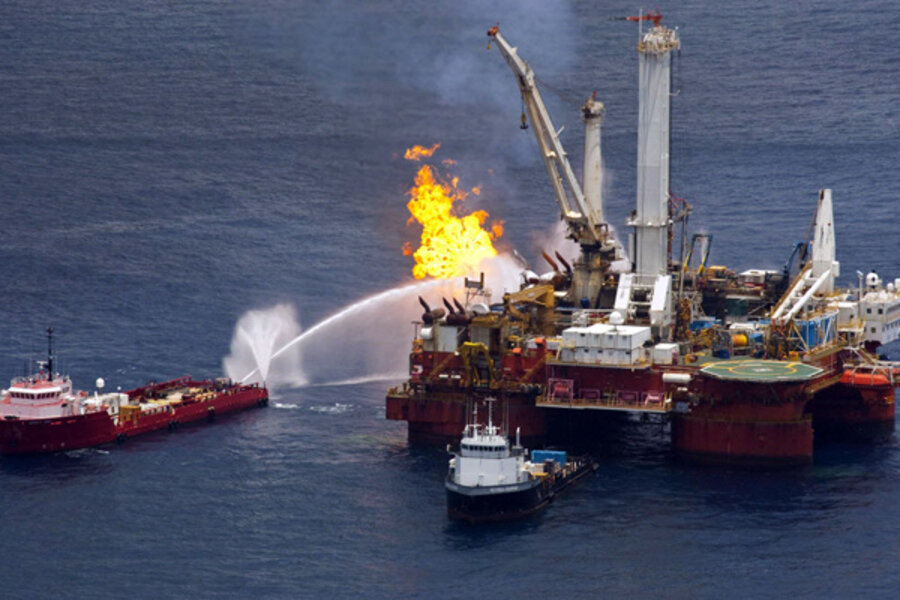Transocean, Halliburton blast BP report on cause of blowout, oil spill
Former partners with BP in the drilling operation that led to a blowout aboard the Deepwater Horizon drill rig – and a massive oil spill – are striking back at a report they say unfairly paints them as equally responsible for the disaster.
In its four-month study by 50 analysts, BP details "a complex and interlinked series of mechanical failures, human judgments, engineering design, operational implementation and team interfaces." Failures by BP's own staff to correctly evaluate negative-pressure tests were part of the problem, the report said. But it also cited roles played by crews of Transocean, which operated the Deepwater Horizon rig, and of Halliburton, the company that cemented the well.
Halliburton and Transocean on Wednesday rejected BP's characterization.
"This is a self-serving report that attempts to conceal the critical factor that set the stage for the Macondo incident: BP's fatally flawed well design. In both its design and construction, BP made a series of cost-saving decisions that increased risk – in some cases, severely," Transocean said in a statement.
Among BP's cost-saving moves that Transocean said compromised safety are the following:
- BP opted for a single long run of pipe rather than an alternative approach that would have increased the barriers to gas flow.
- BP failed to conduct a "cement bond log" test to evaluate the integrity of the cement at the bottom of the well, which was what blocked gas and oil from emerging up the production pipe.
- BP installed fewer than one-third of the recommended number of centralizer devices, which Transocean said had the effect of "dramatically increasing the risk of cement channeling and gas flow."
Halliburton, for its part, said BP officials were in charge and signed off on every step of its work as it pumped concrete to the bottom of the well to block the emergence of oil and gas.
"Deepwater operations are inherently complex and a number of contractors are involved which routinely make recommendations to a single point of contact, the well owner," Halliburton said in a statement. "The well owner is responsible for designing the well program and any testing related to the well. Contractors do not specify well design or make decisions regarding testing procedures as that responsibility lies with the well owner."
BP's study detailed eight failures it said led to the disaster, including what it called "weaknesses in cement design and testing, quality assurance and risk assessment" conducted by Halliburton. It faulted Transocean's rig crew, along with BP well site leaders, for having "reached the incorrect view that the test [of cementing the well to close it] was successful and that well integrity had been established."
Transocean personnel, too, might have averted disaster, the BP report continued. They did not, in part, because "the rig crew’s first apparent well control actions occurred after hydrocarbons were rapidly flowing to the surface. The rig crew did not recognize the influx and did not act to control the well until hydrocarbons had passed" through the blowout preventer on the sea floor and into the riser pipe that went to the rig.
“We have said from the beginning that the explosion on the Deepwater Horizon was a shared responsibility among many entities," BP’s incoming chief executive Bob Dudley said in a statement.
One observer familiar with the BP report, who asked not to be named because he is a member of a federal investigative commission, faulted it for not responding to key questions: "Who was in charge at each step – which employer and position, not which individual – was involved in and responsible for making decisions about what specific equipment, materials, and especially procedures?" the observer said in an e-mail. "What information would be provided to help or be a reference for the rig site personnel in implementing those decisions?"
Given the high stakes, this latest round of finger pointing may have been inevitable. With an investigation by a presidential commission under way, and another by the US Coast Guard, not to mention a criminal inquiry by the US Justice Department, a determination of what happened – and who had ultimate responsibility – will help decide how much each party will pay in fines and criminal penalties.
None of the companies is likely to elicit much sympathy in Congress either, when lawmakers reconsider the matter of tightening safety in the offshore drilling industry.
"I look forward to seeing the final results of the multiple other investigations not funded by BP or the other companies involved in this disaster," said Rep. Edward Markey (D) of Massachusetts, chairman of the Energy and Environment Subcommittee and Select Committee on Energy Independence and Global Warming, in a statement. "Those are the reports that will tell the real story of this disaster, and give us the lessons we need to create laws that will prevent this type of accident from happening again."





